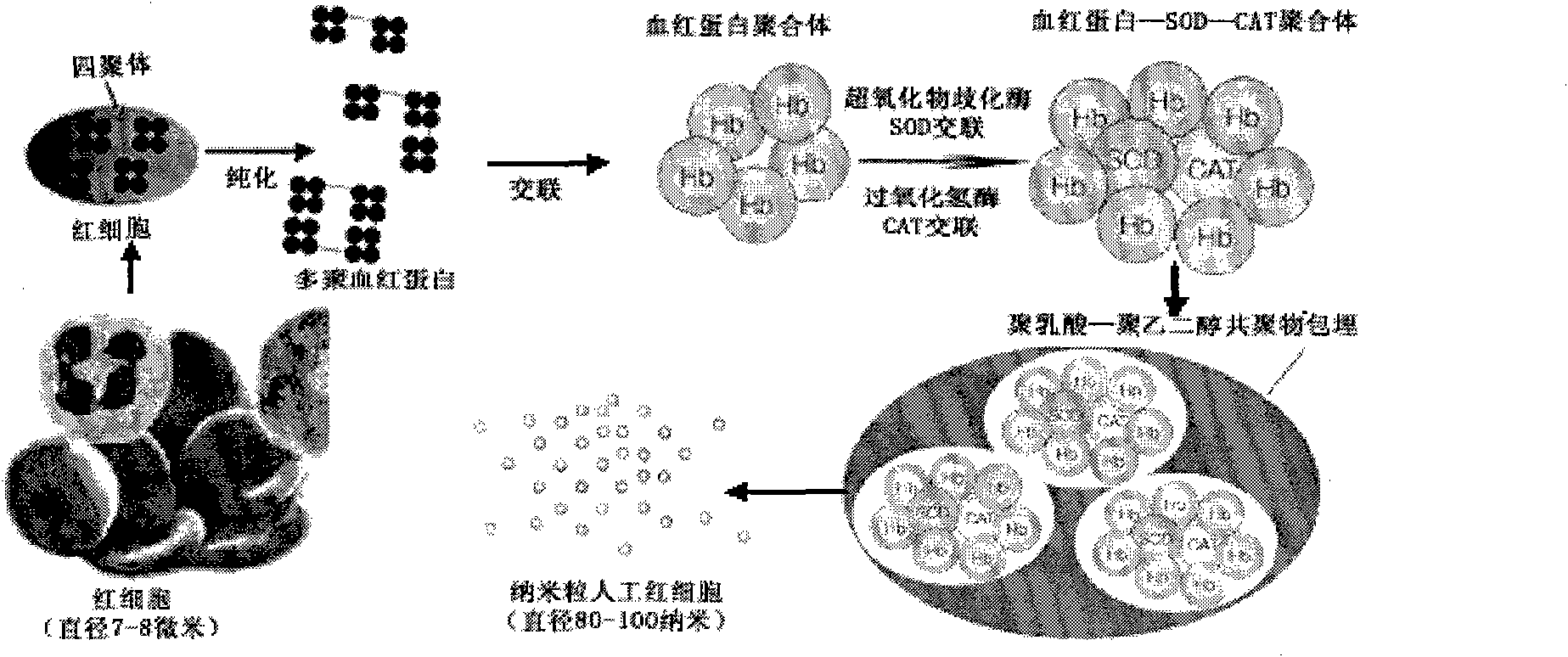Preparation method for novel red blood cell substitute-artificial red blood cell fluorescent nanoparticles
A nanoparticle and red blood cell technology, which is applied in the direction of extracellular fluid diseases, medical preparations with no active ingredients, medical preparations containing active ingredients, etc., can solve the problems that blood substitutes cannot be directly applied, and achieve low price and source wide range of effects
- Summary
- Abstract
- Description
- Claims
- Application Information
AI Technical Summary
Problems solved by technology
Method used
Image
Examples
Embodiment 1
[0020] Embodiment 1: the preparation of stroma-free hemoglobin (Hb)
[0021] Stroma-free hemoglobin is prepared by lysing bovine red blood cells with low osmosis, extracting with toluene, purifying by high-speed centrifugation, and ion-exchange chromatography. The final solution contained 0.1-0.15 g / mL hemoglobin. In order to reduce the formation of methemoglobin, the operation process was carried out at 4°C under a nitrogen atmosphere, and the pH value of the hemoglobin solution was 7.4.
[0022] (1) Separation of bovine red blood cells
[0023] Take fresh bovine blood and put it into several aseptically treated centrifuge tubes, and centrifuge at 4000xg for 10 minutes. After taking out, the upper layer of plasma and middle layer of white blood cells were sucked out, and the lower layer of red blood cells was mixed with 0.9% normal saline and centrifuged at 4000×g for 10 minutes. The supernatant was discarded, and the red blood cells in the lower layer were washed with nor...
Embodiment 2
[0028] Example 2 Preparation of polyhemoglobin PolyHb-SOD-CAT-CA complex cross-linked with superoxide dismutase (SOD), catalase (CAT) and carbonic anhydrase (CA)
[0029] The three enzymes were added to the purified hemoglobin solution at a ratio of 300,000 U catalase: 15,000 U superoxide dismutase: 100 U carbonic anhydrase: 1 g hemoglobin. Before crosslinking, add 1.3M lysine at a molar ratio (lysine:hemoglobin) of 10:1 and shake for 1 hour, then add 0.5M glutaraldehyde at a molar ratio of 17:1 (glutaraldehyde:hemoglobin), and crosslink for 10 -24 hours, the degree of molecular cross-linking was monitored by HPLC, and when the desired degree of cross-linking was reached, 2M lysine solution was added to the solution to terminate the cross-linking reaction. After the Lactate Ringer solution was dialyzed overnight, excess modifiers and other small molecular substances were removed through a Sephadex G-25 chromatographic column. The operation process was carried out at 4°C under...
Embodiment 3
[0030] Example 3 Polylactic acid, polyethylene glycol copolymer (PLA-PEG) nanoparticles embed PolyHb-SOD-CAT-CA complex to prepare artificial red blood cell nanoparticles
[0031] (1), the preparation of PLA-PEG copolymer
[0032] 1.5 g of DL-polylactic acid (molecular weight 16,000) and 0.75 g of methoxypolyethylene glycol (molecular weight 2,000) were dried in vacuo overnight. It was heated to 180° C. for 2 hours under the protection of nitrogen. After adding 10 μL of stannous 2-ethylhexanoate, the mixture was heated to 180 °C for 3 h under nitrogen protection to obtain the final polymer PLA-PEG copolymer, which was soluble in acetone.
[0033] (2), preparation of artificial red blood cell nanoparticles
[0034] Organic phase: 150 mg of PLA-PEG copolymer dissolved in 8 ml of acetone was mixed with 50 mg of hydrogenated soybean lecithin dissolved in 4 ml of ethanol, and 0.05% coumarin-6 was added as a fluorescent marker.
[0035] Water phase: Mix 0.04 ml of Tween 20 with 2...
PUM
 Login to View More
Login to View More Abstract
Description
Claims
Application Information
 Login to View More
Login to View More - R&D
- Intellectual Property
- Life Sciences
- Materials
- Tech Scout
- Unparalleled Data Quality
- Higher Quality Content
- 60% Fewer Hallucinations
Browse by: Latest US Patents, China's latest patents, Technical Efficacy Thesaurus, Application Domain, Technology Topic, Popular Technical Reports.
© 2025 PatSnap. All rights reserved.Legal|Privacy policy|Modern Slavery Act Transparency Statement|Sitemap|About US| Contact US: help@patsnap.com

